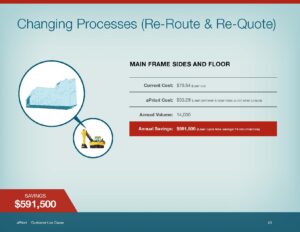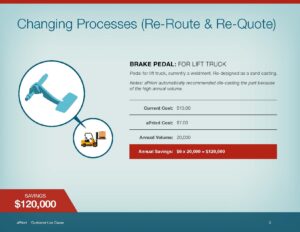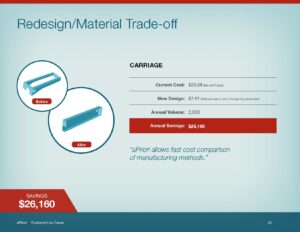
What if you could have real-time feedback for estimated supplier costs based on geographical location; for educated, fact-based supplier negotiations; and for building a more resilient supply chain during supply chain disruptions?
Today’s supply chains are predominantly built around the Just-In-Time (JIT) concept. JIT is a supply chain strategy in which raw materials are moved to the required location just before they are needed for manufacturing. Typically, this is a fantastic strategy to help reduce inventory costs. The manufacturer is able to keep less raw materials on hand; but is also completely dependent on a reliable and synchronized network of material movement and correct forecasting of demand.
But this year is anything but typical.
In 2020, a pandemic disrupted the entire world – unlike anything that has been seen in the past 100 years – and certainly not within the age of globalization. Because the virus causing this global pandemic is novel, no viable treatment or vaccine yet exists. This simple fact has affected businesses worldwide. Countries have been forced to impose travel restrictions, stay-at-home or lockdown orders, and forced closure of many businesses.
The Manufacturing Industry Has Suffered
In this article, we are focusing primarily on how the manufacturing industry has been affected by the above-mentioned pandemic-fighting measures. Businesses forced to shut down due to travel restrictions imposed have caused substantial supply chain disruptions worldwide. Specific ways supply chains have been disrupted, specifically, those who rely on JIT, include:
- When travel is restricted, raw materials/goods cannot be moved as easily
- When businesses are closed, manufacturing suppliers may not be able to produce the raw materials/goods required to support downstream processes
- The amalgamation of the fallout from a pandemic then impacts forecasted demand
These restrictions have had a major impact on the world of business today, from small mom-and-pop suppliers to the world’s largest OEMs.
Trade Wars Haven’t Helped
The global pandemic is having quite a large impact on global supply chains, but it also stands to reason that there is an additional impact as a result of the American/Chinese Trade War. The United States has recently levied tariffs on Chinese goods being imported, resulting in higher cost of goods. These tariffs, coupled with growing labor costs (64% increase from 2011 to 2016 and another 30% increase from 2016 to 2020)1 has seen companies explore shifting supply chains to lower-cost countries/regions such as Mexico and Southeast Asia.
With the growing cost of manufacturing in China and the increased tariffs imposed by the U.S., JIT supply chains may face further disruptions due to raw materials not being available at the required time and location. This breakdown in the synchronization of movements of goods throughout the end-to-end supply chain could lead to reduced finished goods availability and increased cost of such.
How Can You Get Real-Time Feedback for Estimated Supplier Costs?
Digital manufacturing simulation software, utilizing digital factories, can solve problems and overcome challenges much like what the world is facing today.
Digital manufacturing simulation software is a tool that will provide an estimation of what to expect for a cost to manufacture. A digital factory is the model employed by the digital manufacturing simulation tool that represents an existing manufacturing site. In other words, a digital factory applies all the real-world assumptions of a manufacturing site into a mathematical and physics-based model that carries out the requisite calculations to arrive at a cost estimate to manufacture the component in question.
How Can Digital Manufacturing Simulation Improve Supply Chain Management?
Geographical cost differences are only a single element of what a digital manufacturing simulation tool can provide in terms of supply chain disruption management. Other elements include:
- Improved supplier relations through fact-based negotiation
- To learn more, read our article, How to Use Fact Based Negotiation to Get the Best Price on Existing Components.
- Longer-term supply chain resiliency through diversification
- Meaningful cost input to aid in real-time decision making
Through a digital manufacturing simulation tool like aPriori, you can implement solutions that will drive the following outcomes:
1. Regional Cost Analysis – A single component can be run through various digital factories from different geographical regions to determine if there is value in relocating the manufacturing location.
Download aPriori’s datasheet on Regional Data Libraries here.
2. Detailed Cost Breakdown Reports – Rapidly generate reports, either locally or via the web, to break down costs by the specific manufacturing process. This provides the ability to have more fact-based negotiations or conversations with suppliers.
3. Alternative Manufacturing Routing Analysis – Quickly analyze alternative manufacturing processes to determine which is the most appropriate – taking supplier availability and cost into consideration.
4. Alternative Material Analysis – Efficiently determine if there is potential to switch to a different material with similar mechanical properties and a lower cost.
5. Supply Chain Planning Analysis – Use the previously outlined methods of analysis to build an entire picture of how to better plan the supply chain:
- Which region of the world should you manufacture in?
- Are there multiple regions you should look at to ensure supply chain resiliency?
- Ensure the appropriate manufacturing process is being used based on capability and cost.
- Determine the optimal combination of mechanical properties and cost for materials.
Case Studies: Manufacturers Using Digital Manufacturing Simulation Software to Improve Supply Chain Management
A heavy industrial manufacturer was able to achieve an annual savings of ~$600K simply by using aPriori to determine an alternative routing that proved to be more cost-effective.
Another heavy industrial manufacturer was able to achieve an annual savings of $120K by changing the manufacturing from a weldment to a single casted piece.
In leveraging aPriori’s capabilities, another manufacturer was able to compare designs (decreased component size) and materials (moving from nickel plating to galvanizing) to see an annual savings of over $26,000.
Conclusion
Digital manufacturing simulation software is instrumental in alleviating some of the pressures seen in today’s global climate. It can uncover previously unidentified savings opportunities to help maintain and improve business profitability, reduce supply chain disruptions, and foster productive supplier relationships.
Want to learn more about how to use digital factories to model supply chain changes? Download our guide to digital factories.
RISK-PROOF YOUR SUPPLY CHAIN
Learn how to use data to mitigate the cost of supply chain disruptions and turn supply chain resiliency into a competitive advantage.








